Dog pools
A refreshing summer option
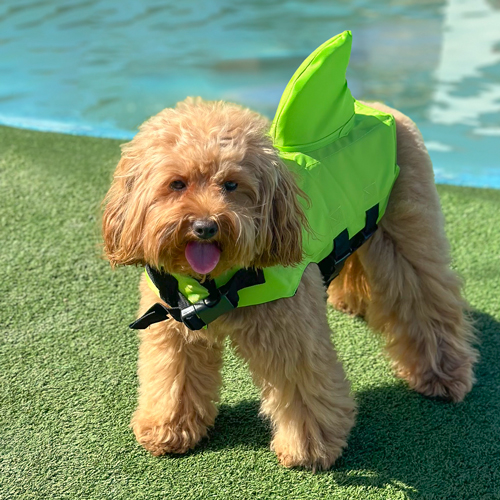
ARE SWIMMING POOLS ADVISABLE FOR DOGS?
Reading time about 8 minutes
Just like people, when high temperatures arrive, dogs may feel very hot and suffocated. You can notice that your pet is more listless and less willing to play. Have you ever thought about buying a dog pool? There are many types of pools on the market that are specially designed for use by these animals, made of more resistant materials and of different sizes.
But is it good for dogs to bathe in the pool? The answer is yes (although some precautions should be taken into account), as it allows their body temperature to regulate, and helps them to relax and cool off during very hot weather.
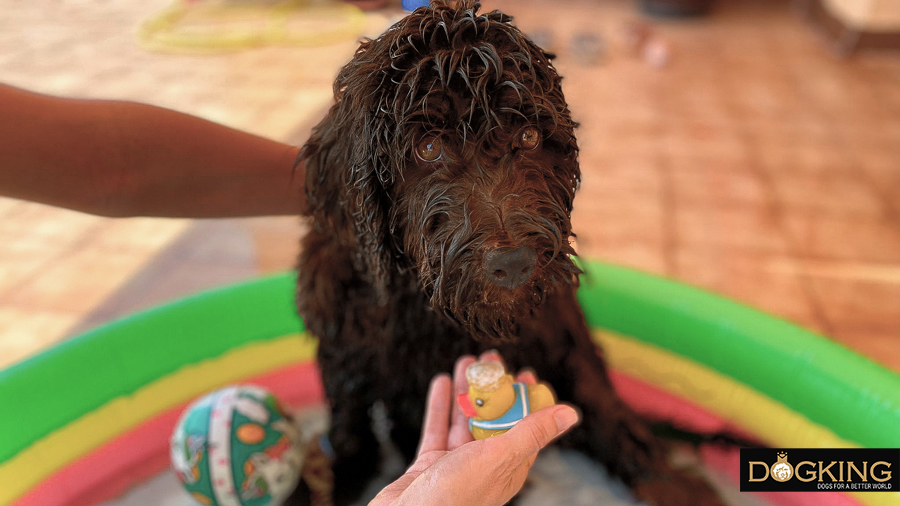
Table of contents
1- How to choose a good pool for my dog?
2- Can my dog swim in my swimming pool?
3- Public swimming pools for dogs
4- What happens if my dog is afraid of water?
How to choose a good pool for my dog?
Many people make the mistake of buying conventional pools for use with their dogs. The result is that the material, which is too flimsy for the teeth and nails of these animals, lasts very only few days before breaking down, making them a waste of money that isn't advisable. On the other hand, pools for dogs are usually made of PVC, a very resistant material that is suitable for our pets. In addition, when you go to buy a dog pool, take into account that it meets the following requirements and consider our recommendations.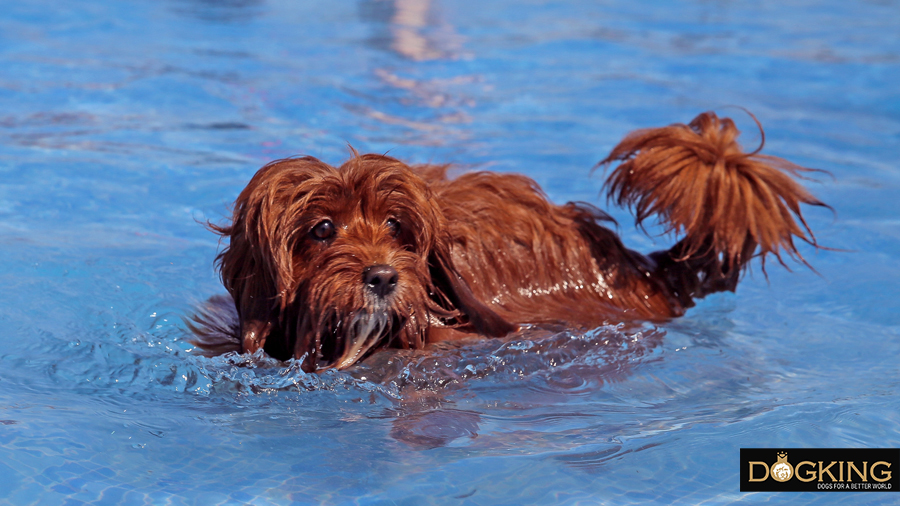
A foldable dog pool
Although there are some inflatable dog pools that promise to be sturdier than the typical kiddie pools, foldable pools are a much more durable option. Their material is usually stronger and more rigid and they incorporate a non-slip treatment on the bottom for a better grip. In addition, although they aren't as light as inflatable pools, you can easily fold them up for storage when the summer is over. On the other hand, most inflatable pools for dogs are actually children's pools that break quickly due to the friction of the animal's nails and teeth.
The right size
The right pool for your dog is one that is wide enough for it to lie down, stretch out, roll over and, in short, feel free and relaxed. However, if your dog is small or medium-sized, be careful with the height of the pool, as your pet should be able to reach the edge of the pool to get out of the water whenever it wants. Even if your furry friend can swim, the dimensions of the pool should allow it to get in and out of the pool easily when your dog needs to.
Easy to install
When the summer and the hot weather arrive, we don't feel like doing heavy tasks, so if you don't want your dog's pool to be left unopened in a corner of the garage, choose simple installation models. Be very well informed about the assembly process so that your dog can enjoy its pleasant baths without complications.
Drainage for emptying
It seems obvious, but not all dog pools have a drain for emptying. If you have a small dog and use a small-sized pool, this isn't very important, as it won't take too long to empty the pool (you can empty the water quickly in the bathtub), but if your dog's pool is bigger, emptying the water with buckets isn't going to be funny. However, a pool with a drain empties quickly so you could spend that time cleaning the pool until the next use.
The best place to put the dog pool
Once you have bought the ideal pool for your dog, you will have to choose a good place to put it. We recommend a shady place, as if it spends too many hours in the sun your pet could suffer from sunburn or sunstroke. Choose a flat surface, with no overhangs, rocks or slopes. Some people with small or medium-sized dogs prefer to improvise homemade pools with washbowls, but these should be put in the coolest and most ventilated places possible, as they aren't usually heat-resistant and may get too hot, causing the water to heat up very quickly.
Make it fun!
If you want your pet to never forget its summer baths in the pool, be sure to put its favourite underwater toys in the water. You can also opt for pools with water jets, which will make bath time much more fun.
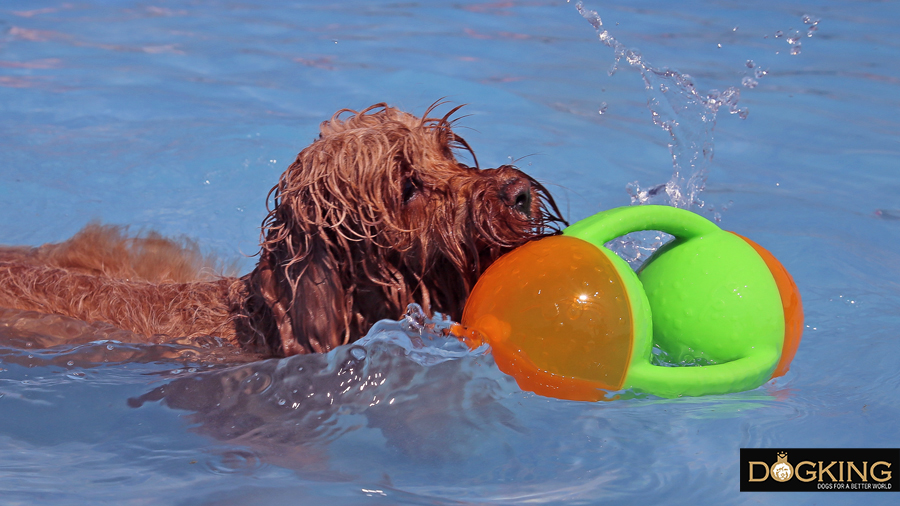
Precautions when bathing your dog in the swimming pool
As a member of your family, your dog also deserves to enjoy a relaxing and fun swim in your swimming pool. However, keep in mind these recommendations to avoid any kind of problem:
- Protect your dog from the sun. Place the pool in a shady spot or, if that isn't possible, use dog sunscreen and reapply every few minutes according to the instructions for use on the label. Even in this case, it isn't advisable for a dog to spend too much time in the sun, so it is safest to combine short swims with rest periods.
- Brush it before and after swimming. If you brush your dog before entering the water, you can remove excess hair, dust and dirt, which will keep the pool cleaner for longer. In the case of long-haired dogs such as Australian Cobberdogs, it is necessary to brush them before the bath, so that any tangles they may have can be undone beforehand, as wet hair makes the knot close tighter, and then when it comes time to dry the hair we have a bigger problem.
- Rinse its coat. After bathing, you should rinse your dog with clean water to remove any dust, leaves or grass that may have fallen into the swimming pool during the bath. The water in dog pools is stagnant and although it should be kept clean and changed periodically, it is a good idea to give your dog a cool shower to complete its bath.
- Dry it very well. After getting out of the water, dry your pet's ears, as well as its pads and the area under its tail, with a dry towel or cloth. Wet coat is much more prone to infection, and blow-dry it at home so that the deepest parts of its coat aren't left wet.
- Up to date vaccination and deworming. Water is a medium in which some bacteria proliferate more easily, so it is essential that your dog is protected to avoid infections. In fact, puppies shouldn't swim in a public swimming pool if they haven't completed their compulsory vaccination, as they are more vulnerable to these diseases.
- Don't feed it before or after. To avoid heat shocks with digestion, it is preferable that you don't feed your dog one hour before or one hour after swimming in the pool. Of course, don't feed your dog in the water either.
Can my dog swim in my swimming pool?
If you have a swimming pool on your plot or in your garden, you can let your dog swim in it, but always under your supervision. In fact, your dog shouldn't have access to the swimming pool unless you are with it, so be sure to protect it with a fence if necessary. Even if your dog can swim, it is dangerous for it to be alone in the water, as it could suffer from problems, such as a muscle cramp, a wasp sting with an allergic reaction, a sunburn, etc.
In addition, you should make sure your dog doesn't drink water from your swimming pool, as the chlorine and the chemicals it contains to keep it clean could cause poisoning, with symptoms such as vomiting or diarrhoea. If your pet has drunk water from your swimming pool and you think it may have chlorine poisoning, take it to the vet immediately. Besides, prolonged contact with chlorine may cause skin and eye irritation and dryness in its coat. After your dog enjoys a swim with you in your swimming pool, remember to give it a shower with clean water and soap to remove any chlorine or other chemicals from its coat and skin.
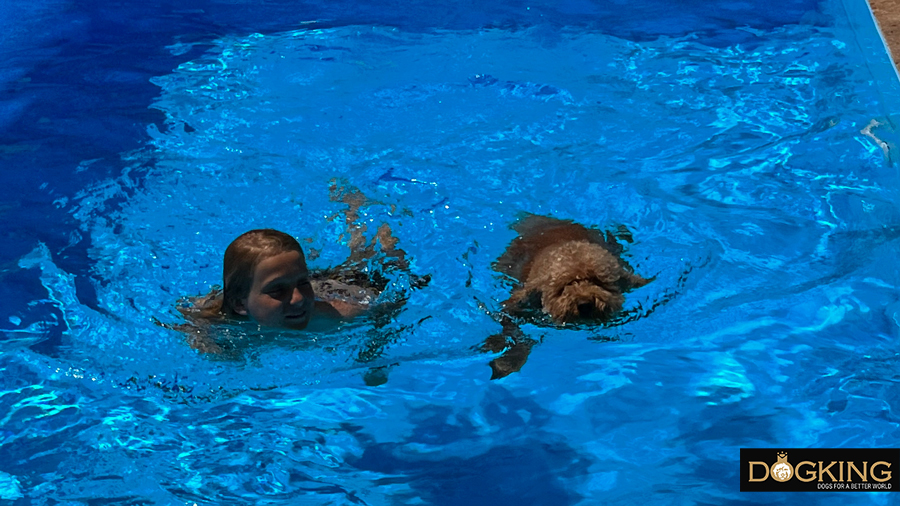
Public swimming pools for dogs
Finally, a great option for your dog to enjoy a nice summer swim are public swimming pools for dogs. There are more and more swimming pools of this type, with slides and different depths. In these canine aquatic facilities you have to follow some rules, such as the type of dogs allowed in each area, the vaccination and deworming of animals to be able to access, thus avoiding the proliferation of infections.
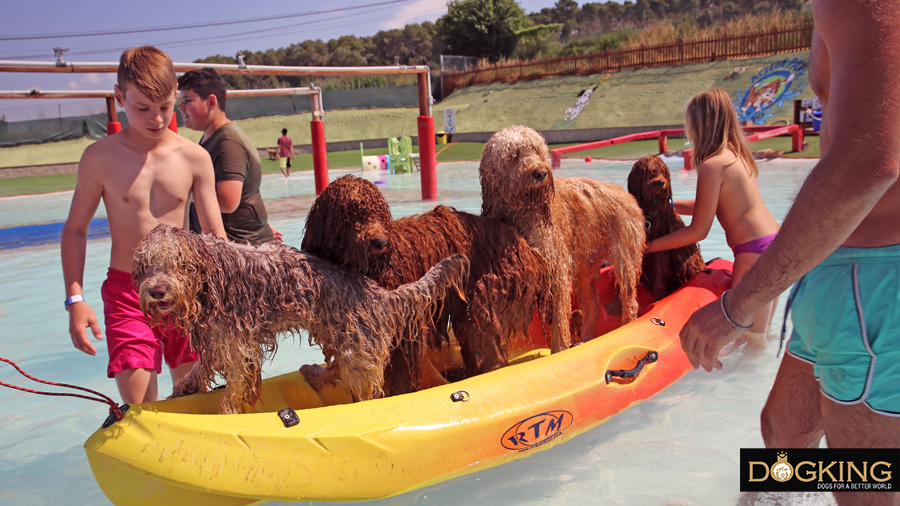
What happens if my dog is afraid of water?
Most dogs can swim instinctively, but not all breeds have the same facility. No matter how hot your pet is, and no matter how much you think it would benefit from a swim in the pool, you should never force it into the water if your dog is afraid, which is more often the case with large swimming pools for people. Make sure exposure to the swimming pool is gradual. You can play with its favourite toys in the water and let it simply watch you. You can enter the swimming pool and interact with your dog from the inside and, little by little, you will awaken your dog's curiosity. It should be normal for it to go into the water on its own after a while, but if you don't see any progress or interest on its part, don't force your dog to do so under any circumstances.
Every dog has its own personality and preferences and the idea is that you find a way to cool off and enjoy the summer together, whether it is a nice swim in the swimming pool, a few runs along the seashore or a shower with the garden hose.